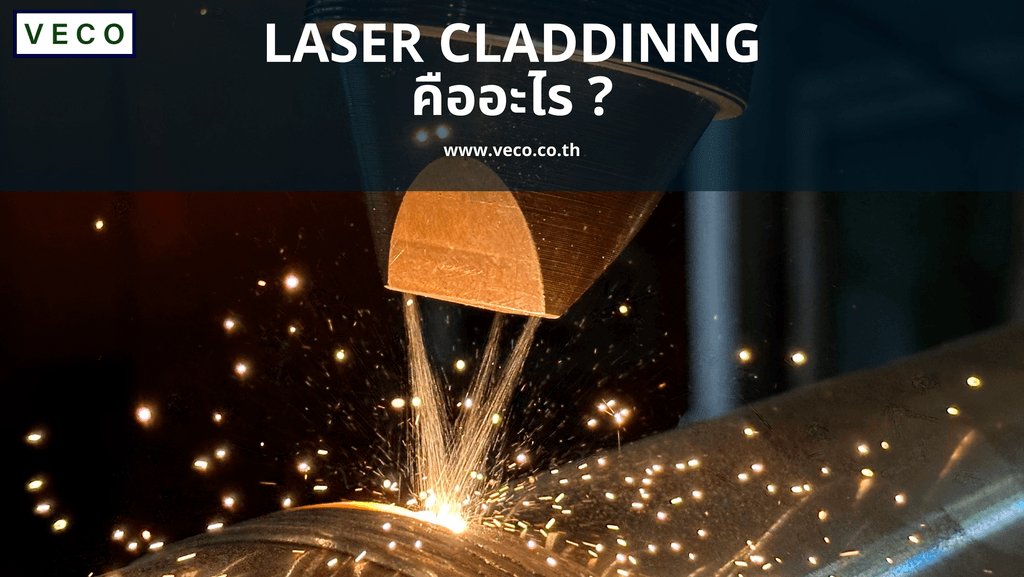ข้อมูลทั่วไปของ Laser cladding
Laser cladding คือการเชื่อมชนิดหนึ่งโดยการใช้แสงเลเซอร์ที่มีความเข้มข้นสูง ยิงไปที่ผิววัสดุเพื่อให้เกิดบ่อหลอม จากนั้นจะมีการพ่นผงโลหะลงไปที่บ่อหลอมเพื่อให้ให้ผงที่พ่นลงไปหลอมรวมกับเนื้อวัสดุเดิมกลายเป็นผิวเชื่อมขึ้นมา
การทำ Laser cladding เป็นวิธีการที่ควบคุมคุณภาพงานเชื่อมได้อย่างแม่นยำ เนื่องจากทุกๆขั้นตอนนั้นจะเป็นระบบอัตโนมัติ (Automation) ซึ่งจะทำให้การผลิตซ้ำในทุกๆชิ้นงานจะได้คุณภาพที่เหมือนกันทั้งหมด อีกหนึ่งข้อดีนั้นคืออุณหภูมิในการเชื่อมที่ต่ำ ซึ่งจะไม่ทำให้วัสดุเปลี่ยนคุณสมบัติหรือทำให้ชิ้นงานโก่ง คด บิด งอ ในขณะเดียวกันก็ยังเป็นวิธีที่ทำให้วัสดุที่เติมเข้าไปหลอมรวมกับวัสดุเดิมเป็นเนื้อเดียวกัน ซึ่งจะไม่ทำให้ผิวหลุดร่อนแต่อย่างใด
อีกหนึ่งข้อดีที่มีมากกว่าการเชื่อมแบบปกติ (TIG,MIG) คือการที่บ่อหลอมที่เกิดจากการใช้แสงเลเซอร์จะน้อยกว่ามาก ซึ่งจะทำให้วัสดุที่เติมลงไปไม่ไปกวนเข้ากับวัสดุเดิม จะทำให้ได้คุณสมบัติของวัสดุที่เราต้องการเติมลงไปอย่างแท้จริงตั้งแต่ชั้นแรก ต่างจากการเชื่อมปกติซึ่งอาจจะต้องทำถึง 2-3 ชั้นจึงจะได้คุณสมบัติของวัสดุที่เติมลงไปจริงๆ ตามปกติแล้วค่า Dilution ของการทำ Laser cladding นั้นจะอยู่ที่ 5%
หลักการทำงานของ Laser cladding

หลักการทำงานของ Laser cladding นั้นจะคล้ายกับ Laser welding หรือการเชือมเลเซอร์เป็นอย่างมาก ซึ่งจะเริ่มจากการที่เครื่องปล่อยแสงเลเซอร์ความเข้มข้นสูงไปที่ผิววัสดุ ซึ่งในขณะเดียวกันจะมี Shielding gas เพื่อปกป้องชิ้นงานจากการเกิด Oxidation ปล่อยออกมาด้วย จากนั้นเครื่องจะปล่อยผงโลหะลงไปที่บ่อหลอมที่เกิดจากแสงเลเซอร์ เกิดเป็นผิวเคลือบขึ้นมาในที่สุด แต่ข้อดีสำคัญที่มีมากกว่าการเชื่อมเลเซอร์คือการที่ 1.เนื่องจากใช้ผงเป็นวัสดุเติมลงไป จึงทำให้สามารถเลือกโลหะผสมคาร์ไบด์เป็นวัสดุเคลือบได้ 2. เนื่องจากเป็นขั้นตอนอัตโนมัติ 100% ทำให้การเชื่อมพื้นที่ใหญ่นั้นประหยัดต้นทุนไปได้มาก
Venture Engineering คือผู้นำด้าน Laser cladding ยินดีให้คำปรึกษาฟรี รายละเอียดเพิ่มเติม “คลิก”
ทำไมต้องเลือกใช้ Laser cladding ?
การเชื่อมแบบปกตินั้นมีการให้ความร้อนที่สูงมากแก่ชิ้นงาน ซึ่งสามารถทำให้วัสดุเปลี่ยนโครงสร้างและนำไปถึงปัญหาเพลาขาดในหลายๆครั้ง รวมถึงความร้อนที่สูงจะทำให้ชิ้นงานมีการเปลี่ยนรูปร่างเช่น โก่ง คด บิด งอ ด้วยเป็นต้น ซึ่งตรงกันข้ามกับการทำ Laser cladding ที่มีการให้ความร้อนแก่ชิ้นงานที่น้อยมาก เพราะฉะนั้นจึงเหมาะแก่การนำมาซ่อมชิ้นงานที่สำคัญของลูกค้าทั้งหลายโดยไม่เปลี่ยนแปลงคุณสมบัติวัสดุ
คุณสมบัติเด่นของ Laser cladding
- ใช้ความร้อนน้อยมาก จึงไม่ทำให้เหล็กเปลี่ยนโครงสร้าง หรือชิ้นงานบิด
- ผิวที่ได้หลอมรวมกับผิวชิ้นงาน แน่น ไม่มีรูพรุน ไม่หลุดร่อน
- สามารถทำซ้ำได้โดยไม่กระทบแก่คุณภาพงาน เนื่องจากเป็นขั้นตอนอัตโนมัติ 100%
- สามารถเชื่อมงานได้อย่างรวดเร็ว (2-3.5 kg/hr)
- สามารถเลือกวัสดุได้หลากหลายกว่าการเชื่อมปกติหรือการเชื่อมเลเซอร์ เช่นกลุ่ม Tungsten Carbide
| Arc Welding | Thermal Spray | Hard-Chrome Plating | Laser Cladding | |
|---|---|---|---|---|
| Heat Input | High | Low | N/A (Chemical process) | Low |
| Dilution Rate | 10-40% | N/A (mechanical bonding) | No metallurgical bond | <5% |
| Hardness (HV) | Relatively low | <1000 | 800-1000 | >1000 |
| Distortion | High | Low | N/A | Low |
| Heat Affected Zone | Large and wide | Low | N/A | Low |
| Quality | Less durable | Prone to chipping and delamination | Prone to chipping and delamination | Highly dense and long life |
| Pre/Post Treatments | Many | Many | Many | Few |
| Automation | Difficult | Difficult | Difficult | Easy |
| Coating Thickness | >0.020" | 0.020"-0.040" | 0.002"-0.006" | >0.020" |
Venture Engineering รับบริการ Laser cladding ยินดีให้คำปรึกษาฟรี รายละเอียดเพิ่มเติม “คลิก”


Laser cladding choice of materials
| Material | Typical Hardness (HV) | Thermal Stability (°C) | Application |
|---|---|---|---|
| High Strength Steels (M2, H13) | 550-650 | 450-500 | Dimension restoration, Tool repair |
| Aluminium Bronze | 200-300 | 350-400 | Good wear resistance, good general corrosion resistance. Ship propeller shaft. |
| SS309, SS316L | 250-300 | - | Used as root layer/build up, relatively good general corrosion resistance |
| Stainless 420 | 550-600 | 500-550 | Great wear resistance. Dimension restoration. |
| Rockit 431SR | 690-710 | 400-600 | Excellent wear resistance as well as corrosion resistance. Proven succcess for laminar cooling roll |
| Rockit 606 | 890-950 | 500-550 | Very hard and corrosion resistance. Great impact resistnace. Used for chrome replacement but better |
| Stellite-6 | 550-600 | 500-550 | Excellent galling, wear, erosion, and cavitation protection over a wide temperature range |
| Stellite-21 | 400-450 | 500-550 | Superior thermal and mechanical shock resistance, relatively high resistance to galling and cavitation |
| Hastelloy C-276 | 380-450 | 870-1230 | Moderate wear resistance with exceptional corrosion resistance against acid, alkali or other media. |
| Inconel-625 | 250-300 | 900-1000 | Applied in extremely high corrosive environments, used as buffer layer |
| Inconel-718 | 400-450 | 600-650 | Age hardenable, high temperature stability and corrosion protection. Used for oil&gas industry. |
| Ni80-Cr20 | 300-350 | 1000-1100 | Hot oxidation resistance |
| NiCrBSi-30%WC | 1200-2000 | 600-650 | Great abrasion/erosion resistance and excellent for part-to-part sliding wear due to relatively low friction coefficient |
| NiCrBSi-60%WC | 1500-2300 | 600-650 | Exceptional abrasion/erosion resistance and excellent for part-to-part sliding wear due to relatively low friction coefficient |
| NiCrBSi-65%WC | 1500-2500 | 600-650 | Extremely high abrasion/erosion resistance and excellent for part-to-part sliding wear due to relatively low friction coefficient |
| Colmonoy-63 | 600-650 | 500-550 | Excellent resistance to aluminum liquid erosion used in high pressure die cast |
| Colmoynoy-88 | 720-840 | 600-650 | Exceptional wear resistance coupled with great corrosion resistance. |
| Titanium Gr.5 | 330-360 | 400-600 | Excellence strength to weight ratio. Great corrosion resistance. |

